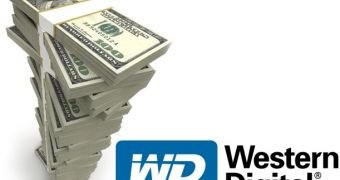It’s clear that HDD capacity is still in high demand and the demand will only grow in the following years. That’s why profit mongering HDD company Western Digital has reportedly discussed new technologies to increase the capacities and performance of its products, yesterday at a conference in Vienna, Austria.
It seems that the annual growth of the medium HDD product capacity has slowed down from 40 percent per year to just 20 percent last year.
This is likely due to the fact that perpendicular magnetic recording (PMR) is maturing and there won’t be such impressive gains in the following period.
As a matter of fact, the medium annual HDD capacity growth is likely to decrease in the following years until new technologies such as shingled recording technology start to improve the situation.
The thing is that stacking PMR tracks one over the other will cause the write speed to decrease dramatically, as writing the underlying tracks will require the top tracks to be rewritten as well.
This won’t provide any impressive increase in read speeds, just the usual sequential read speed increase we’ve got on a yearly basis in the last decade and that’s absolutely mediocre.
The write speed, on the other hand, will be severely affected and the durability of the drives will hit similar problems as the SSDs have right now.
Maybe it won’t be just as prevalent, but durability will surely be a problem in shingled HDD media, as it was never before in a HDD.
The company seems to believe shingled HDD technology is a necessary step towards energy-assisted magnetic recording technology (EAMR). But EAMR tech, or heat-assisted recording technology (HAMR) as Seagate likes to call it, won’t be around in the next 3 to 5 years.
We’ll probably see shingled media HDDs in the next 3 to 4 years, but EAMR can only follow later.
The fact that we must bear through the disadvantages of shingled platters is not a likable picture for the future HDD buyer.
In the following years, the only novelty will be the slow increase in the performance of current solutions.
The thing is that buyers don't exactly need hybrid drives, as the combination of a SSD with the OS and a HDD with the rest of the data is currently the best solution. That's hybrid enough for most of us.
A hybrid HDD will never be faster than the combination of a fully fledged SSD with a normal HDD.
That's one of the reasons that the HDD crisis was very useful for Seagate and WD.
Lacking any new technology to impress the buyers and also lacking the ability to significantly increase capacity, HDDs have quickly became something taken for granted. Terabyte prices dropped and margins were smaller than ever.
Hybrid drives never impressed anyone and practically came and went unnoticed, while being shamelessly overpriced and disliked by the users that preferred the SSD plus HDD combination.
Solution? Buy all the main competition and then, when the right moment comes, exploit the de facto duopoly that was created.
Therefore, now that they're still milking the HDD crisis' effects, WD is talking about their future products this year. But that will be discussed in Part II of our HDD Market Status 2012.

 14 DAY TRIAL //
14 DAY TRIAL //